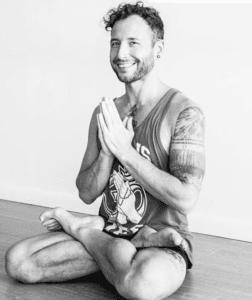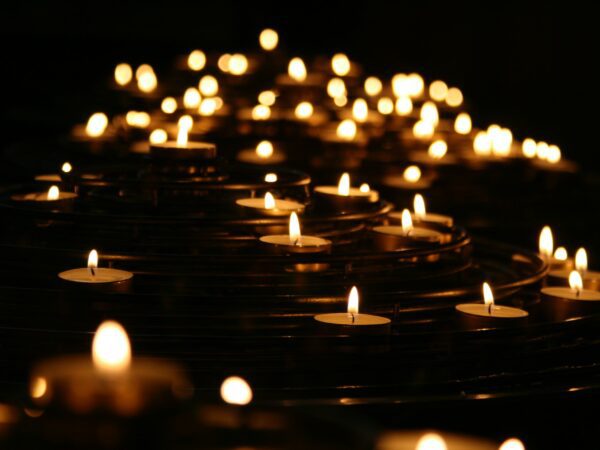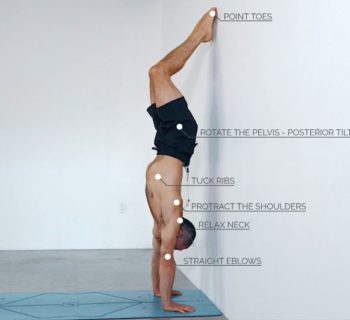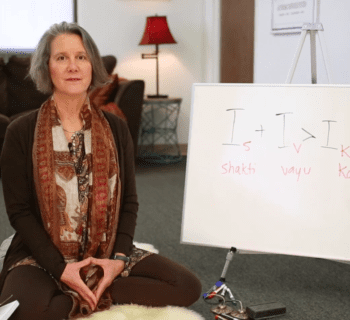How much do you know about your favorite OMstars teachers and they’re relationships to yoga? Get ready to find out! Earlier this month we hosted the #ActualizeYogaChallenge with Joseph Armstrong, and if you joined the challenge, you had the opportunity to practice with him on OMstars – The Yoga Network. So this month, we reached out to Joseph to ask him all about his experience with and relationship to yoga, plus a whole bunch of other yoga related questions. These are his answers…
- How long have you been practicing yoga and why did you start?
I began my practice in 2008. I started when a friend invited me to class. I dabbled casually for quite a while, unknowing that it would eventually transform everything.
- What is yoga to you?
On a physical level, Yoga is a process of creating stress in the body and learning to remain calm and relaxed at the same.
On a psychological level, Yoga is a revelatory process that helps us realize behavioral patterns that we are stuck in and emotional tendencies that are repeating and controlling our lives.
On a spiritual level, Yoga is about seeking. Perhaps finding we are neither the body nor mind, but something else entirely.
- How did you feel after your first yoga class and how do you want students to feel after they practice with you?
I have an addictive personality. After my first class I knew I wanted more.
I don’t care how my students feel after practice. 🤷🏽♀️ It will vary. Sometimes they’ll feel great. Sometimes they’ll feel like shit. How they feel after any given practice is less important than the fact that they show up with regularity for the long haul. It’s this dedication that will light the fire of yoga in their lives.
- What impact has yoga had on your life? Who were you before you started practicing and how have you changed, evolved and transformed?
The inevitability of everything has become very clear. No matter my grasping or great revulsion, life will happen just the same. The external world will unfold as determined by laws of cause and effect. My opinions and ideas are equally a result of that phenomenon.
Sometimes I feel yoga is a tool that has helped me restructure my life. Before yoga I was a drug dealer, a liar and a thief. I was existentially morbid and inconsolable. I could not make peace with my place in the world.
Sometimes I feel that I am a tool that’s helping yoga restructure the universe. I am hopeful now. I’m certain that I am power for good, because I aim to be of service. I am to help those who are suffering as I once did. I have blueprints for living.
Where once there such great doubt and terrible fear and need for answers, now there is comfort with uncertainty. There’s an adventurers heart. There is a love for possibilities and questions that creation poses.
- Why did you decide to start teaching yoga and what makes a good yoga teacher?
I failed miserably at everything so tried before I committed to yoga. I managed restaurants, sold kids furniture, worked in a carpets factory in the middle of nowhere. You name it… Yoga is the only thing I’ve felt might allow me to devote a life time to it.
Whenever someone tells me I’m a good teacher, I tend to respond: I’m only doing what my teachers taught me to do. I believe my skill as a teacher derives from my own mentors and our shared devotion to tradition.
On the other hand, I do have a curious and questioning heart. So I tend to seek both the scientific and spiritual underpinnings of practice. I seek common ground between the two.
- What style of yoga do you practice and what makes that style most effective? Do you have a teacher in your style of yoga?
I practice and teach Ashtanga yoga primarily. It’s very effective in that the sequence is highly structured. Using the Tristhana Method (3 points of convention, movement, gaze and breath) the practice is directed and stabilized. Once these details are memorized, and with substantial practice, the process becomes a meditative one.
My teachers are R. Sharath Jois, Tim Feldmann and Kino MacGregor.
I also teach multipractice classes which incorporate Asanas, breath work and mindfulness meditations. I call the practice Actualize. These classes are structured to increase self-observation and utilize the power of the parasympathetic nervous system for relaxation response.
- What advice would you give to someone who is just starting out on their yoga journey?
I kept a practice journal when I first committed to a regular practice. On my second day, the notes read something along the lines of: ‘Hopped on bike and headed towards studio. Turned around half way. Too nervous. Did sun salutations at home instead.
Starting can be intimidating. And it’s okay to be nervous or scared even. For me the vital part was just not to give up. No matter what keep coming back, even if there are some fits and starts.
- What has been your biggest struggle and your biggest milestone in the practice?
I struggle with maintaining a deep breath. I smoked my first cigarette when I was 13 and then half a pack a day from the time I was 18 until I was 35. I have had to put a lot of thought into what breath control is in my practice and how to make peace with my very reduced lung capacity. Everyone’s experience of practice will be a bit different, it’s important to see that and fit the practice to differing abilities.
- What is your favorite yoga pose and why? And what’s your least favorite yoga pose and why?
I feel my current work in second series Ashtanga has been a milestone. This sequence has tested my resolve and required me to develop a new level of physical strength from a never-before-tapped well of determination.
I’ve learned to appreciate that I will not love every posture every day, but it’s important I do them all the same. Likewise, I shouldn’t get too attached to the ones I sometimes gravitate towards, because who knows when injury or illness might make them go…
Karandavasana has been my buddy for some time now, though. It’s been the slowest progression of my yoga asana development. For over a year I’ve gotten steadily stronger. Recently I lifted my lotus up with some amount of control and confidence. A year ago my nervous system was a wild electrical storm every time the pose approached. Today I remain calm and focused. Something deep within me has shifted. I feel at peace and proud of my long-term dedication. Proud because I suspect I now have something to offer others, because of my devotion and determination I can now be of service to others.
- What has been the most inspirational moment you’ve experienced as a yoga student? And how about as a teacher?
As a student my most inspirational moment was walking into the KPJAYI Shala in Mysore India for the first time. To be called in by my teacher, Sharath Jois, and given a spot to practice under his guidance was pure magic. There’s something very special about that place and I’m so lucky to have been, and to be returning in June of this year.
This Mysore Magic inspires my teaching too. It’s only because of this method that I am able to share yoga well, with a sureness granted by the thousands of teachers and practitioners who have come before me. Every practice of Ashtanga yoga begins with the count ‘Ekam, Inhale’. Each time I hear this count, I raise my arms above my head and look up. It’s like I’m moving in unison with every Ashtangi throughout time. It’s powerful.
- What’s your favorite yoga quote or mantra?
I think often about the Amit Ray quote:
Self-observation is the first step of Inner unfolding.
I also am very inspired by the quote from drag queen superstar, RuPaul:
We’re all born naked and the rest is drag.
- What is the single most defining issue facing the global yoga community today?
Yoga is and always has been about developing a more neutral mind, so that we might see the world as it truly is and not as we want it to be. This stillness may offer some revelation. I can’t speak for the masses, but for me this search for clarity defines my practice more than anything else. Even if it’s just my doubts I’m seeing more clearly. I believe many in the modern world are yearning for a neutral, secular yoga. Spiritual, not religious, practice.
- What’s the most embarrassing thing that has ever happened to you as a student and as a teacher?
Being a recovered addict, it follows that I burned up a lot of valuable brain cells in my misspent youth. Learning new things can be a challenge. Memorizing the sequence of Ashtanga yoga was overwhelming for me initially. I was so embarrassed every time I had to ask my teacher, yet again, what the next pose was.
Today when I have students who struggle with memorization I feel such empathy. I almost always tell them they can ask me as many times as they need. I joke that if they weren’t there to ask me so many questions I’d be out of a job completely!
- Do you have any recommend yoga reading?
Moola Bandha: The Master Key is a great, easy read. Filled with practices for and philosophy of deep core awareness, it’s been so helpful in my own practice.
- What is your dharma, your life mission?
In recovery lingo, we say: If you wanna keep what you have, you have to give it away. That’s why I’ve devoted myself to the practice and sharing of yoga. I was a destructive force in the world for so long, but something miraculous occurred when I surrendered to powers greater than myself. My teachers in Ashtanga and my sponsor and peers in Recovery are those greater powers. These people helped me reshape my life, they did for me what I could not do for myself. They set me free to thrive. They gave me a gift that is transmissible, I can help others now. This is my sacred responsibility.
Joseph Armstrong











